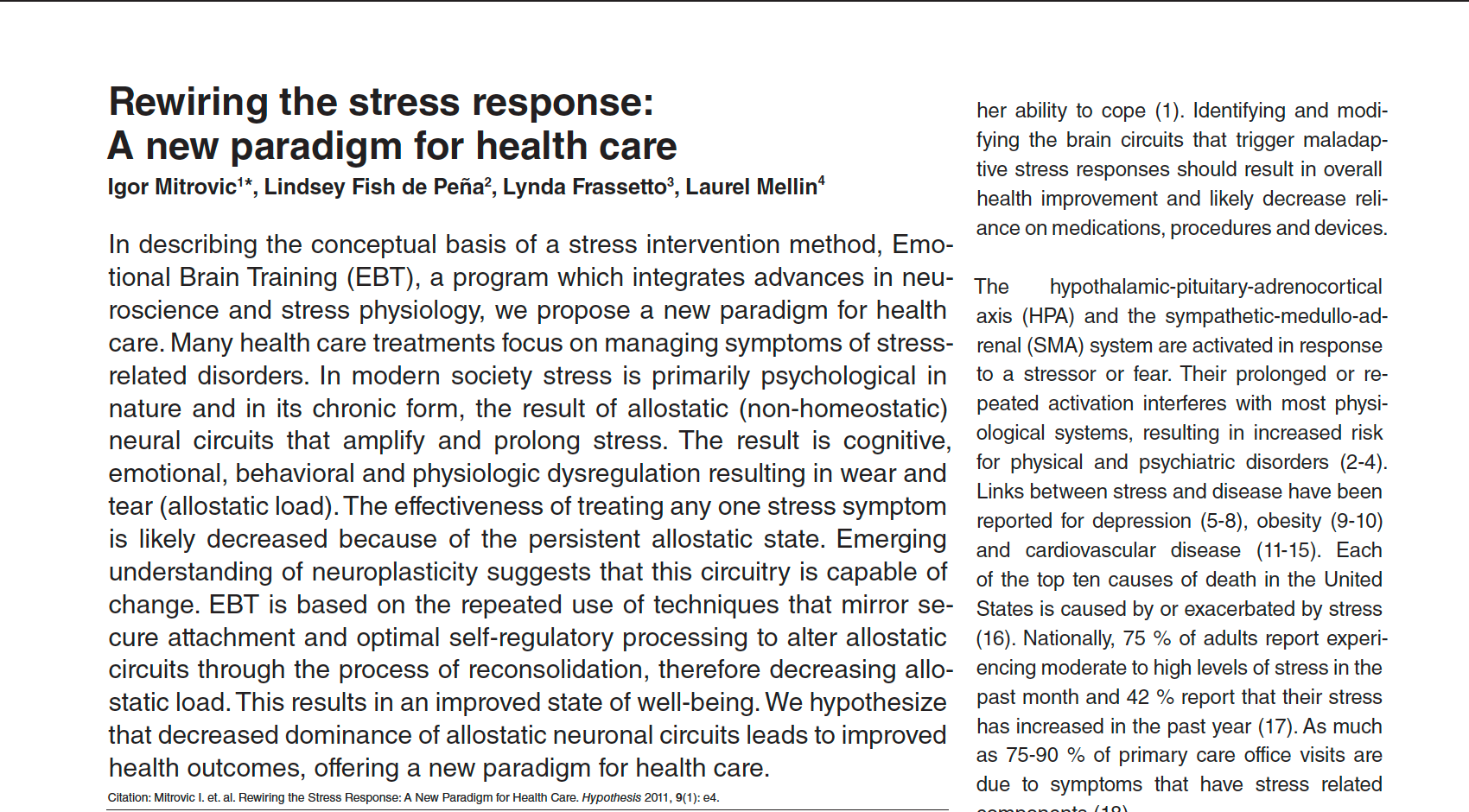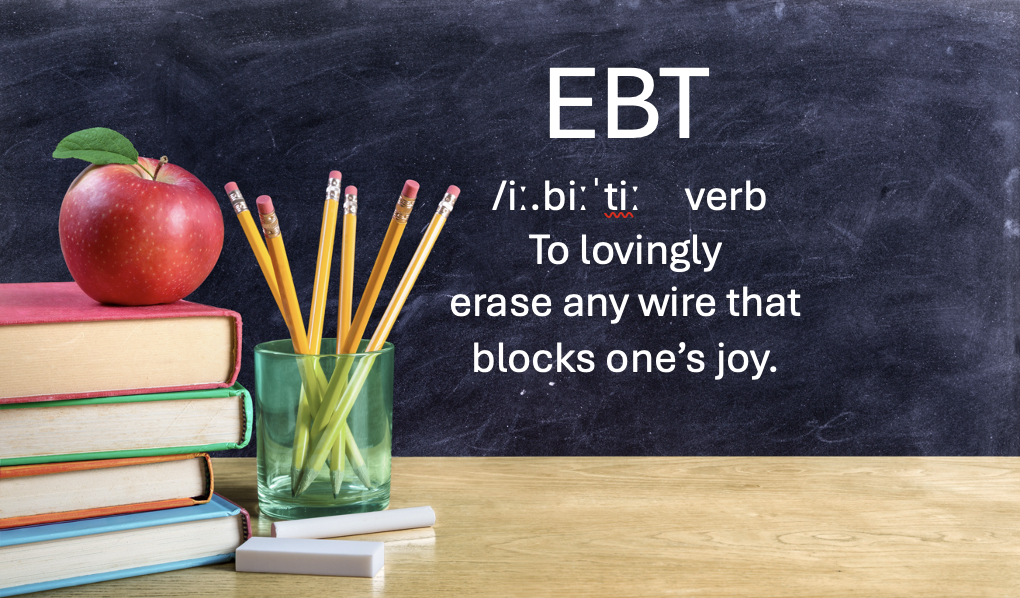In 2007, when neuroscientist Igor Mitrovic, MD, clinical research professor Lynda Frassetto, MD, then medical student Lindsey Fish, and I discovered EBT, we had no idea what to call it.
I had been nursing along since 1978, a method of processing emotions based on three stress levels. The earlier version of the method was called The Solution, but now we had expanded the skill set to cover the whole range of stress states and training about brain circuitry. In a research meeting, a renowned psychiatry professor advised me, "You can't call it The Solution. It sounds too grandiose, so researchers will want to devote their time to studying it."
At the time, I had a few wires of my own that needed erasing, including fear of offending the academic establishment. Plus, I admired and trusted this woman and thought she might just be right.
What would we call it?
Our collaborative team met up and paused. Dr. Mitrovic said that the method now covered resilience (and thus rewiring) for the entire emotional brain, the seat of the soul, survival, physiology, and health. We settled on Emotional Brain Training, as the brain only changes with experience. As therapists become certified in EBT as the new neuroscientific psychotherapy, we could have called it emotional brain therapy. Yet there was something beyond therapy about these tools, as they were both needed and useful in a myriad of ways, as they unlocked our immense power to rewire the elusive unconscious mind.
Sure, it mattered who administered the tools, and even today, we train and certify health professionals in the method. The 30-minute coaching sessions set the brain into motion to heal itself. They are intimate and effective.
The brain needs a little bit of structure
My hope was to make the method the new neuroscientific 12-step, with EBT support groups in every neighborhood. I liked the idea of free, and EBT rewires the same circuits that cause addiction as well as mental and physical health problems. However, we researched the use of self-help groups, and a one-year study showed that they flamed out. The work was deep enough to be transformative, and that disruption of the old circuit needed a provider to create structure, consistency, consultation, and support. We went back to the drawing board and added a dedicated health professional as the group facilitator, and participants thrived, staying in the group for an average of 57 weeks.
Although it is often stated that it takes 30 days to change a habit, changing the set point of the emotional brain requires one year. However, training the brain to stay out of a default state of stress and instead prefer familiarity with joy, flow, peace, and power takes that time. Without that change in set point, the "habit" changes either don't last or do last, but the brain encodes an equally unhealthy substitute.

It was more than therapy . . . a new paradigm
Our original plan for the method's name – Emotional Brain Training – proved right based on the findings from research that followed. The intervention was not just about the provider-participant connection but about community, collective resonance, and a variety of "neuroplastic" experiences. For example, the number of peer connections (five minutes of listening or talking by phone) with another group member predicted health outcomes and how much a participant likes EBT. The EBT Support Groups were the centerpiece of the method, a healthy, inspiring six-person "family" for transformation used to launch the EBT week, but the action that changed the brain (using the app to "spiral up to joy") needed to be both fun and deep, replete with community events, video course viewing, and forum board posting.
All in all, the EBT portal that has evolved is more like a neuroscientific Disneyland of rewiring pleasure and emotional and spiritual evolution than traditional psychotherapy or addiction counseling. That fun, intensity, and diversity of experiences are what the brain needs – and likes. The app has evolved to be user-friendly, with a choice of options: one minute (instant boost), two minutes (quick & easy), or three+ minutes (deep work). It's not one thing, but how the entire experience changes the brain in wondrous ways.

The method was the new medicine, foundational to healthcare, so we called it Emotional Brain Training. Until recently, I thought of EBT as a noun. Then, this morning, I was relaxed, reading the newspaper, an outdated habit I still cherish. It's comforting, no doubt, to enjoy the tactile pleasure of turning the pages coupled with morning coffee and chatting with my husband, Walt. I read him some particularly delicious lines . . . and he darts back with some wise words, at which we both marvel!
It was a story about the newly-opened Notre Dame in Paris and how they matched the grain of the wood, tree by tree, and I thought, "Those architects were so persistent. They must have EBTed a lot."

EBT became a verb
Somehow, saying they must have rewired a lot of circuits, all that reconsolidation of allostatic circuits that cropped up from their childhood or, the stress of it all, I bet they had to crush a lot of ridiculously strong wires that took so much more work and fell short of conveying the "take no prisoners" passion most of us EBTers have for clearing circuits that block our natural state of joy – sometimes gritty joy, but still that state of loving, grounded connection.
So, from now on, look forward to hearing from the EBT Provider of your support group, "Did you EBT it?" When you do, I hope you remember these stories with the larger message that our beautiful, emotional brain has amazing resilience pathways that take us up and over the pain of the day back to our natural state of joy. Whatever comes our way . . . all we must do is EBT it!

